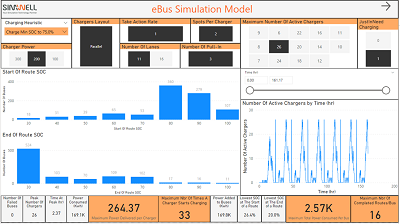
A major transit agency wanted to electrify its bus fleet over a few year period, and they needed to find the best way to design and operate their future transports centers. With an experienced team like theirs it’s common to have the knowledge and intuition to make critical changes and transformations like electrifying their fleet. However, these trailblazing leaders knew this was a big change that they haven’t faced before. Their transportation centers are made of complex, interrelated processes with variability all across the system. They knew they needed a way to capture the unique complexity of their operation including the variability and resource constraints that change over time. The leaders knew they needed a strong decision support tool to help them deploy an electric bus fleet with confidence. The team chose SimWell, an engineering consulting firm with a team dedicated to helping transportation leaders make confident, data driven decisions about their electrisation process.
Their main objective was to choose the best layout for their transportation center, and processes designs to maximize efficiency, save on costs and maintain or even improve service levels for their customers.
Electrifying any small or large bus fleet will always come with theses challenges…
Any trailblazing leader responsible for deploying electric bus fleets knows that the charging process is a challenge. Fluid filing, cleaning, farebox emptying, and pre-departure safety checks are among those processes which must take place in restricted space and according to a very specific sequence.
There are other parameters and sources of complexity that must be considered during the planning phase:
- Charger types, maximum power and center layout
- Charging power smoothing
- Bus charging sequence
- Bus pull-out, pull-in, parking space attribution
- Bus schedule assignments
- And many more…
All theses activities and processes involved are subjected to variability. Transit agencies cannot afford to operate without knowing their systems boundaries. What if absenteeism leads to more processing time in daily operations? What is the impact of unpredictable number of stalled bus at departure buses? What if a snowstorm keeps buses on the roads longer than planned?
The success of the electrification journey relies on choosing the best infrastructure upfront including layouts and processes that will fit normal operation but also will be resilient to degraded conditions, when everything seems to go wrong.
Expect the best, simulate the worst
To overcome theses uncertainties, the team at SimWell built a simulation model that captured everything that made the cities deployment unique including the dynamic processes, routes, traffic, equipment, schedules, and more. With a simulation model of the system, the team was able to analyze the system in a completely risk free environment while running what-if scenarios. It was like literally pressing fast-forward on their electric operation. This transit agency wanted to know more about choosing the best charging infrastructure configuration:
- Optimal charger power: 150 kW, 200 kW or 300 kW?
- Should they recharge 3 or 4 buses at the same time? On the same lane or the same aisle?
- Which is the best recharging sequence, should we quickly fully charge the first bus and the others or recharge them slower but all at once? See the model in action here.
There is a lot of possible combinations just for these three key elements, let alone all the others regular processes interfering with the recharging activity itself.
A simulation model is the best tool to support this kind of decisions
SimWell worked closely with this agency to map their current process and the electrification related processes to add. By using historical data as well as operational plans, a model representing the overall system was built and calibrated to ensure it is true to reality. With an easy-to-use interface, the agency can run scenarios like changing the recharging configuration, modify sequences, schedules, and a lot more – all on their own.

In addition to all the KPIs and reports made available by SimWell, they can use a dynamic animation view that features live metrics and let them witnesses the bottlenecks, pitfalls and success of different scenarios. With a simulation of their transportation center and routes, their level of confidence skyrocketed in every decision they had to take, but the value didn’t stop with finding the right answers for leaders. The model also became a powerful change management tool.
All transit agencies will have to electrify their bus fleet soon or later, how will you deal with uncertainties?
If you’re deploying an electric bus fleet and struggling to answer questions because you have a unique, complex operation SimWell can help. With a simulation model built by SimWell you’ll capture the complexity of your operation and make confident, data-driven decisions.






